Individual Assessment: HRM in a Global Economy (IBU5HRM)
VerifiedAdded on 2023/04/17
|14
|3238
|269
Report
AI Summary
This report analyzes the HRM practices of 'No Name' aircraft, an international company operating in Australia, China, Vietnam, and Singapore. The report addresses CEO Adam O'Meara's concerns about profitability and potential takeover, focusing on four key areas: culture, diversity management, international performance management, and training and development. It identifies communication breakdowns, negative workplace culture, and quality issues stemming from poor integration between teams in different countries. The report examines diversity management practices, highlighting issues such as intolerance between generations and lack of recruitment for people with disabilities. It also assesses international performance management, revealing the absence of formal appraisal processes and inconsistent decision-making. The report emphasizes the importance of cultural sensitivity, effective communication, and clear performance measures to improve the company's overall performance and competitiveness. The report concludes with the need for improved diversity practices, effective performance management systems, and consistent cultural practices across all subsidiaries.
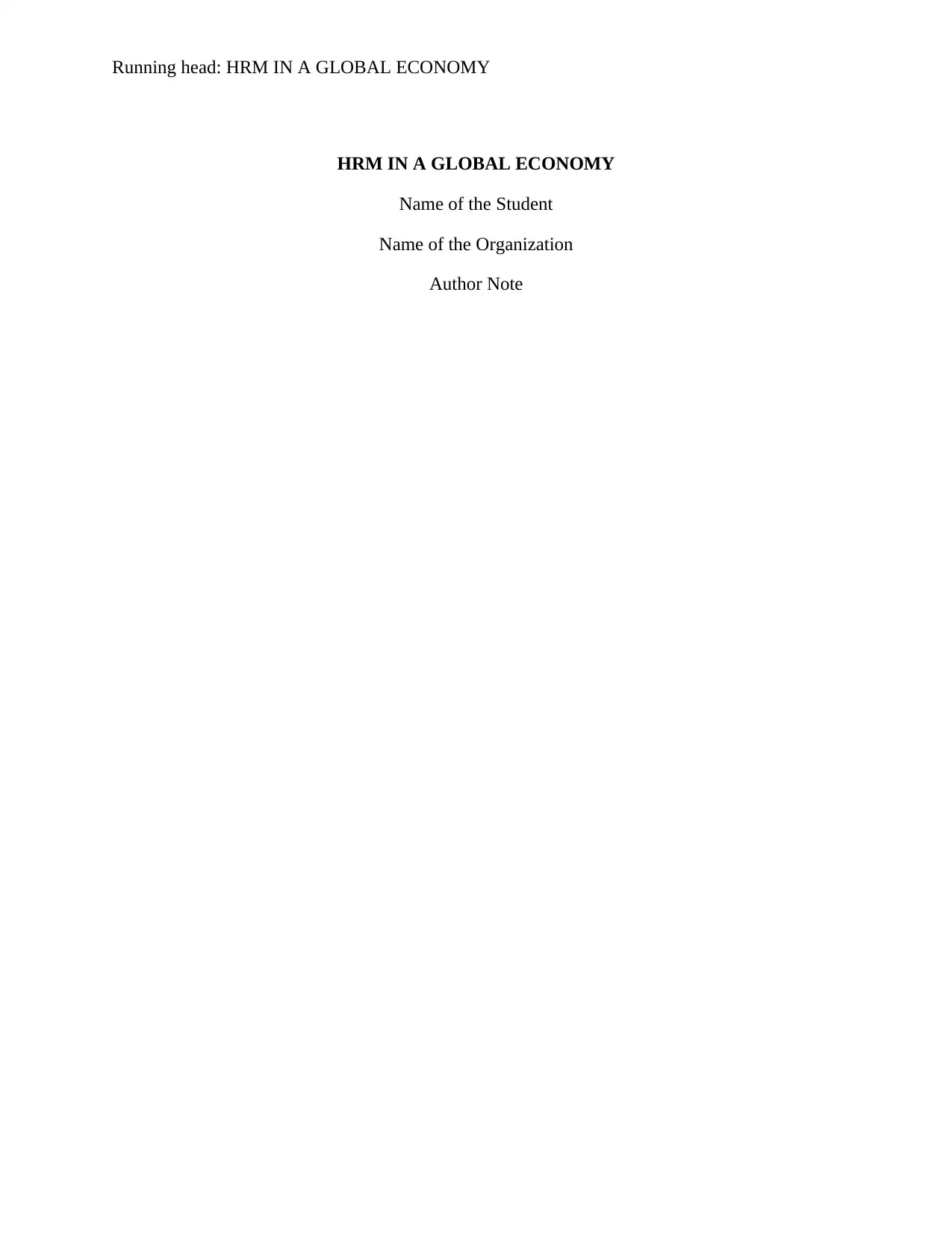
Running head: HRM IN A GLOBAL ECONOMY
HRM IN A GLOBAL ECONOMY
Name of the Student
Name of the Organization
Author Note
HRM IN A GLOBAL ECONOMY
Name of the Student
Name of the Organization
Author Note
Paraphrase This Document
Need a fresh take? Get an instant paraphrase of this document with our AI Paraphraser
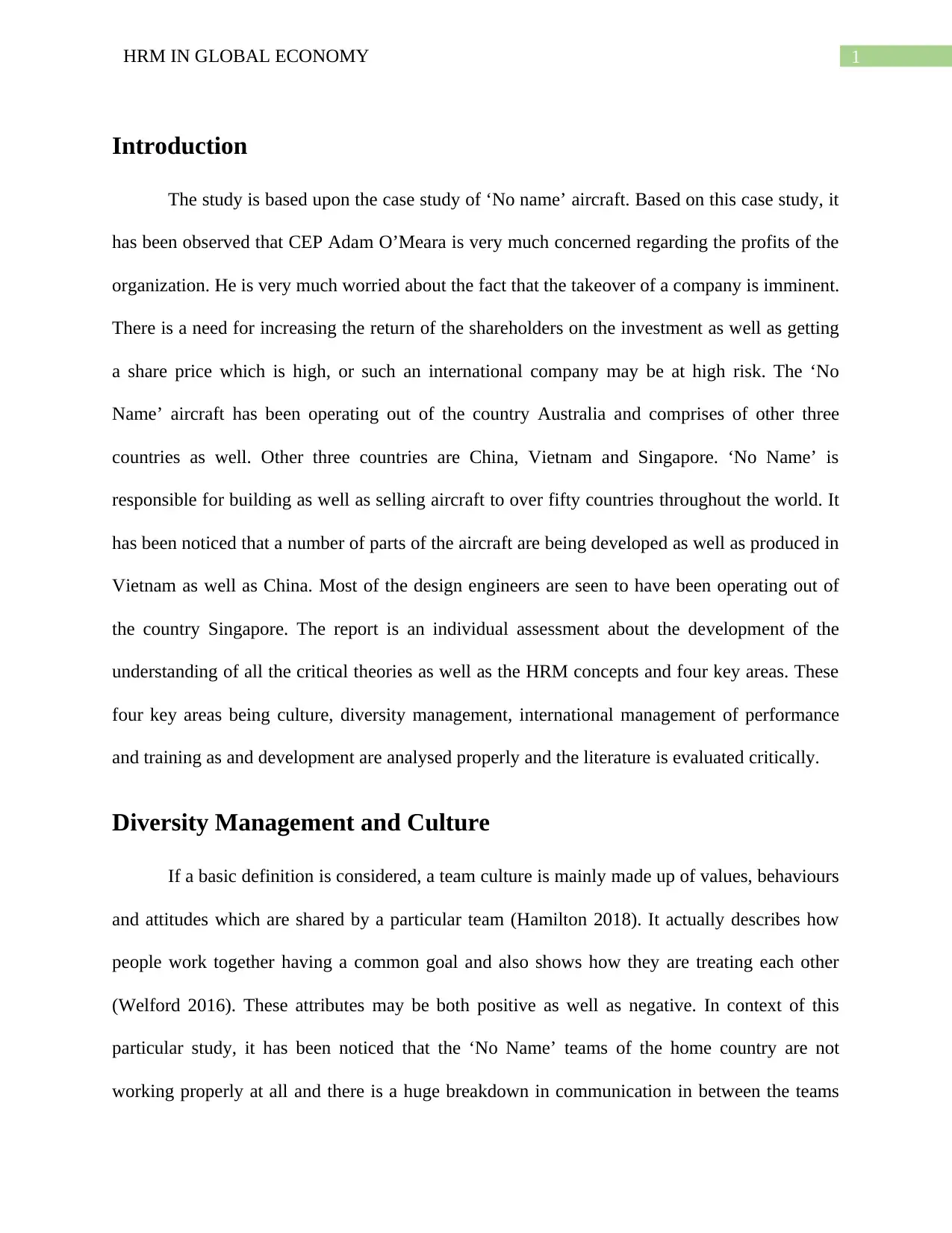
1HRM IN GLOBAL ECONOMY
Introduction
The study is based upon the case study of ‘No name’ aircraft. Based on this case study, it
has been observed that CEP Adam O’Meara is very much concerned regarding the profits of the
organization. He is very much worried about the fact that the takeover of a company is imminent.
There is a need for increasing the return of the shareholders on the investment as well as getting
a share price which is high, or such an international company may be at high risk. The ‘No
Name’ aircraft has been operating out of the country Australia and comprises of other three
countries as well. Other three countries are China, Vietnam and Singapore. ‘No Name’ is
responsible for building as well as selling aircraft to over fifty countries throughout the world. It
has been noticed that a number of parts of the aircraft are being developed as well as produced in
Vietnam as well as China. Most of the design engineers are seen to have been operating out of
the country Singapore. The report is an individual assessment about the development of the
understanding of all the critical theories as well as the HRM concepts and four key areas. These
four key areas being culture, diversity management, international management of performance
and training as and development are analysed properly and the literature is evaluated critically.
Diversity Management and Culture
If a basic definition is considered, a team culture is mainly made up of values, behaviours
and attitudes which are shared by a particular team (Hamilton 2018). It actually describes how
people work together having a common goal and also shows how they are treating each other
(Welford 2016). These attributes may be both positive as well as negative. In context of this
particular study, it has been noticed that the ‘No Name’ teams of the home country are not
working properly at all and there is a huge breakdown in communication in between the teams
Introduction
The study is based upon the case study of ‘No name’ aircraft. Based on this case study, it
has been observed that CEP Adam O’Meara is very much concerned regarding the profits of the
organization. He is very much worried about the fact that the takeover of a company is imminent.
There is a need for increasing the return of the shareholders on the investment as well as getting
a share price which is high, or such an international company may be at high risk. The ‘No
Name’ aircraft has been operating out of the country Australia and comprises of other three
countries as well. Other three countries are China, Vietnam and Singapore. ‘No Name’ is
responsible for building as well as selling aircraft to over fifty countries throughout the world. It
has been noticed that a number of parts of the aircraft are being developed as well as produced in
Vietnam as well as China. Most of the design engineers are seen to have been operating out of
the country Singapore. The report is an individual assessment about the development of the
understanding of all the critical theories as well as the HRM concepts and four key areas. These
four key areas being culture, diversity management, international management of performance
and training as and development are analysed properly and the literature is evaluated critically.
Diversity Management and Culture
If a basic definition is considered, a team culture is mainly made up of values, behaviours
and attitudes which are shared by a particular team (Hamilton 2018). It actually describes how
people work together having a common goal and also shows how they are treating each other
(Welford 2016). These attributes may be both positive as well as negative. In context of this
particular study, it has been noticed that the ‘No Name’ teams of the home country are not
working properly at all and there is a huge breakdown in communication in between the teams
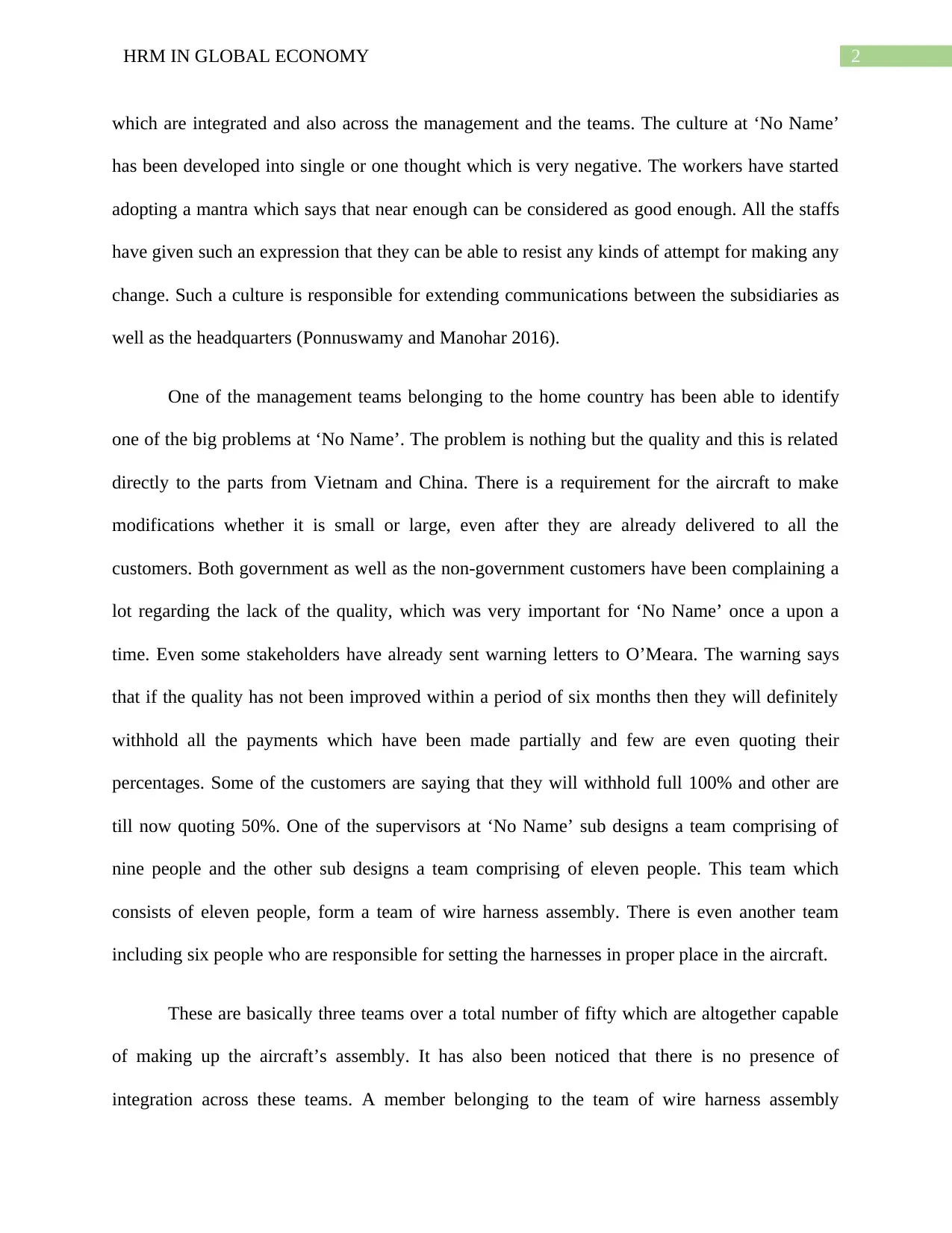
2HRM IN GLOBAL ECONOMY
which are integrated and also across the management and the teams. The culture at ‘No Name’
has been developed into single or one thought which is very negative. The workers have started
adopting a mantra which says that near enough can be considered as good enough. All the staffs
have given such an expression that they can be able to resist any kinds of attempt for making any
change. Such a culture is responsible for extending communications between the subsidiaries as
well as the headquarters (Ponnuswamy and Manohar 2016).
One of the management teams belonging to the home country has been able to identify
one of the big problems at ‘No Name’. The problem is nothing but the quality and this is related
directly to the parts from Vietnam and China. There is a requirement for the aircraft to make
modifications whether it is small or large, even after they are already delivered to all the
customers. Both government as well as the non-government customers have been complaining a
lot regarding the lack of the quality, which was very important for ‘No Name’ once a upon a
time. Even some stakeholders have already sent warning letters to O’Meara. The warning says
that if the quality has not been improved within a period of six months then they will definitely
withhold all the payments which have been made partially and few are even quoting their
percentages. Some of the customers are saying that they will withhold full 100% and other are
till now quoting 50%. One of the supervisors at ‘No Name’ sub designs a team comprising of
nine people and the other sub designs a team comprising of eleven people. This team which
consists of eleven people, form a team of wire harness assembly. There is even another team
including six people who are responsible for setting the harnesses in proper place in the aircraft.
These are basically three teams over a total number of fifty which are altogether capable
of making up the aircraft’s assembly. It has also been noticed that there is no presence of
integration across these teams. A member belonging to the team of wire harness assembly
which are integrated and also across the management and the teams. The culture at ‘No Name’
has been developed into single or one thought which is very negative. The workers have started
adopting a mantra which says that near enough can be considered as good enough. All the staffs
have given such an expression that they can be able to resist any kinds of attempt for making any
change. Such a culture is responsible for extending communications between the subsidiaries as
well as the headquarters (Ponnuswamy and Manohar 2016).
One of the management teams belonging to the home country has been able to identify
one of the big problems at ‘No Name’. The problem is nothing but the quality and this is related
directly to the parts from Vietnam and China. There is a requirement for the aircraft to make
modifications whether it is small or large, even after they are already delivered to all the
customers. Both government as well as the non-government customers have been complaining a
lot regarding the lack of the quality, which was very important for ‘No Name’ once a upon a
time. Even some stakeholders have already sent warning letters to O’Meara. The warning says
that if the quality has not been improved within a period of six months then they will definitely
withhold all the payments which have been made partially and few are even quoting their
percentages. Some of the customers are saying that they will withhold full 100% and other are
till now quoting 50%. One of the supervisors at ‘No Name’ sub designs a team comprising of
nine people and the other sub designs a team comprising of eleven people. This team which
consists of eleven people, form a team of wire harness assembly. There is even another team
including six people who are responsible for setting the harnesses in proper place in the aircraft.
These are basically three teams over a total number of fifty which are altogether capable
of making up the aircraft’s assembly. It has also been noticed that there is no presence of
integration across these teams. A member belonging to the team of wire harness assembly
⊘ This is a preview!⊘
Do you want full access?
Subscribe today to unlock all pages.

Trusted by 1+ million students worldwide
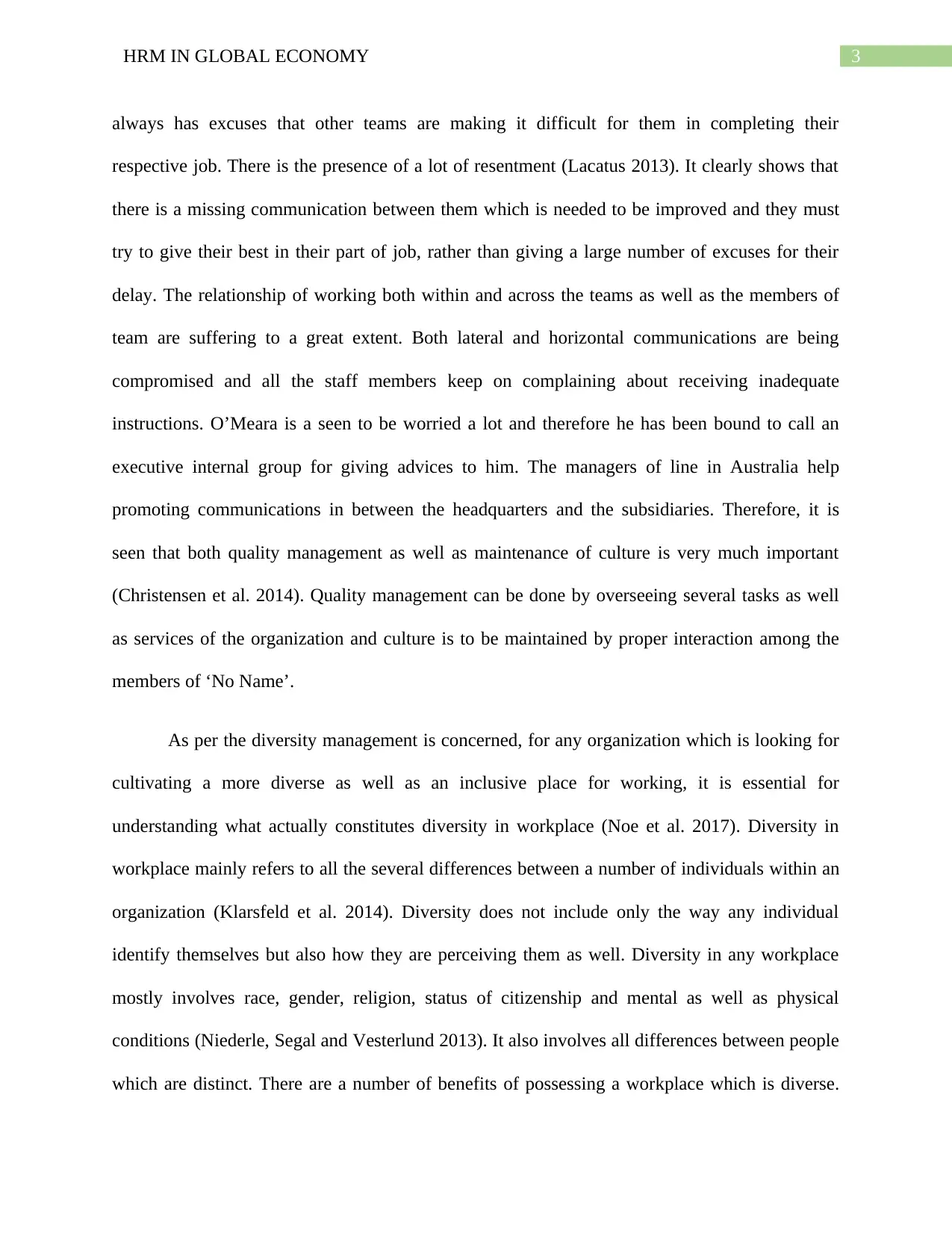
3HRM IN GLOBAL ECONOMY
always has excuses that other teams are making it difficult for them in completing their
respective job. There is the presence of a lot of resentment (Lacatus 2013). It clearly shows that
there is a missing communication between them which is needed to be improved and they must
try to give their best in their part of job, rather than giving a large number of excuses for their
delay. The relationship of working both within and across the teams as well as the members of
team are suffering to a great extent. Both lateral and horizontal communications are being
compromised and all the staff members keep on complaining about receiving inadequate
instructions. O’Meara is a seen to be worried a lot and therefore he has been bound to call an
executive internal group for giving advices to him. The managers of line in Australia help
promoting communications in between the headquarters and the subsidiaries. Therefore, it is
seen that both quality management as well as maintenance of culture is very much important
(Christensen et al. 2014). Quality management can be done by overseeing several tasks as well
as services of the organization and culture is to be maintained by proper interaction among the
members of ‘No Name’.
As per the diversity management is concerned, for any organization which is looking for
cultivating a more diverse as well as an inclusive place for working, it is essential for
understanding what actually constitutes diversity in workplace (Noe et al. 2017). Diversity in
workplace mainly refers to all the several differences between a number of individuals within an
organization (Klarsfeld et al. 2014). Diversity does not include only the way any individual
identify themselves but also how they are perceiving them as well. Diversity in any workplace
mostly involves race, gender, religion, status of citizenship and mental as well as physical
conditions (Niederle, Segal and Vesterlund 2013). It also involves all differences between people
which are distinct. There are a number of benefits of possessing a workplace which is diverse.
always has excuses that other teams are making it difficult for them in completing their
respective job. There is the presence of a lot of resentment (Lacatus 2013). It clearly shows that
there is a missing communication between them which is needed to be improved and they must
try to give their best in their part of job, rather than giving a large number of excuses for their
delay. The relationship of working both within and across the teams as well as the members of
team are suffering to a great extent. Both lateral and horizontal communications are being
compromised and all the staff members keep on complaining about receiving inadequate
instructions. O’Meara is a seen to be worried a lot and therefore he has been bound to call an
executive internal group for giving advices to him. The managers of line in Australia help
promoting communications in between the headquarters and the subsidiaries. Therefore, it is
seen that both quality management as well as maintenance of culture is very much important
(Christensen et al. 2014). Quality management can be done by overseeing several tasks as well
as services of the organization and culture is to be maintained by proper interaction among the
members of ‘No Name’.
As per the diversity management is concerned, for any organization which is looking for
cultivating a more diverse as well as an inclusive place for working, it is essential for
understanding what actually constitutes diversity in workplace (Noe et al. 2017). Diversity in
workplace mainly refers to all the several differences between a number of individuals within an
organization (Klarsfeld et al. 2014). Diversity does not include only the way any individual
identify themselves but also how they are perceiving them as well. Diversity in any workplace
mostly involves race, gender, religion, status of citizenship and mental as well as physical
conditions (Niederle, Segal and Vesterlund 2013). It also involves all differences between people
which are distinct. There are a number of benefits of possessing a workplace which is diverse.
Paraphrase This Document
Need a fresh take? Get an instant paraphrase of this document with our AI Paraphraser
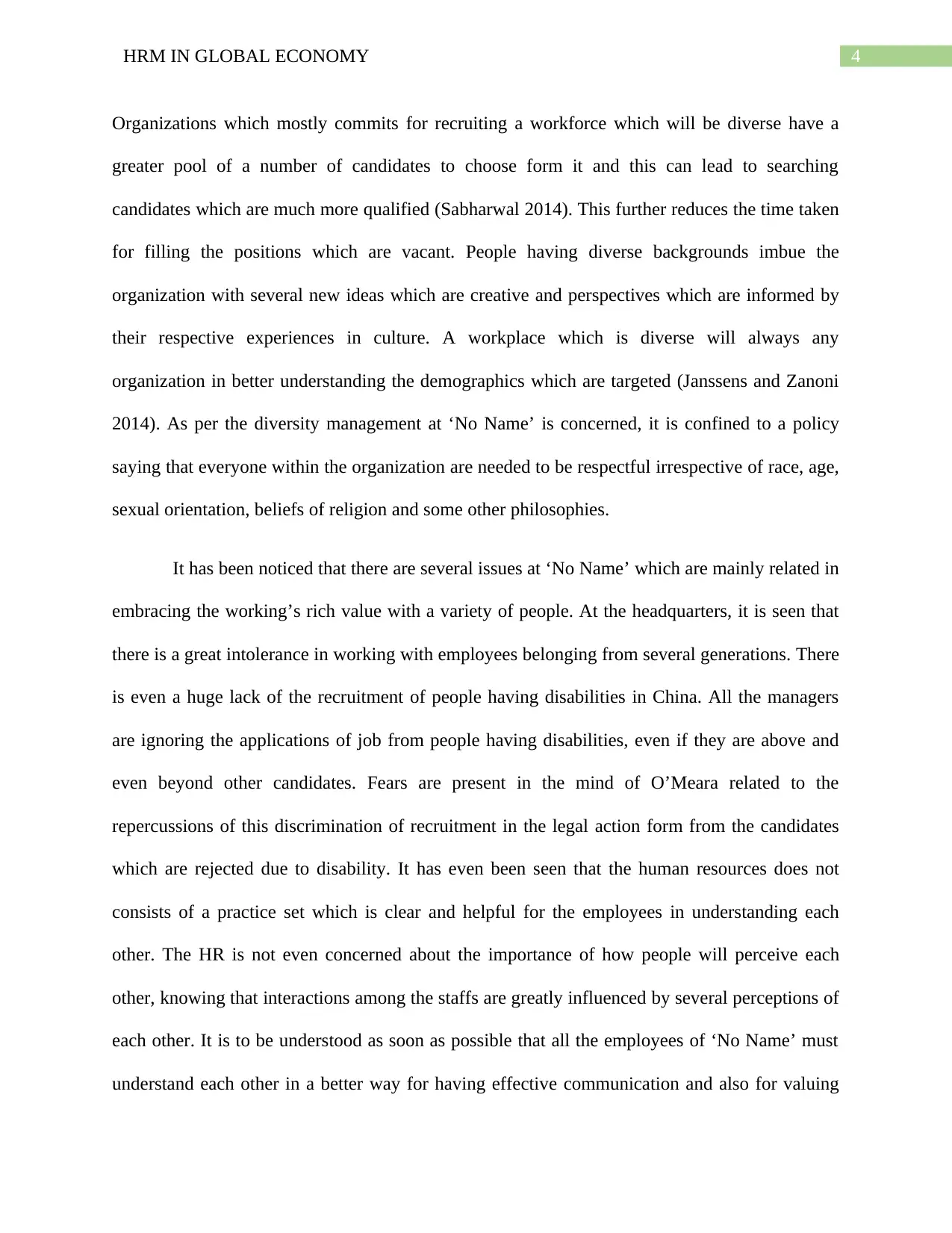
4HRM IN GLOBAL ECONOMY
Organizations which mostly commits for recruiting a workforce which will be diverse have a
greater pool of a number of candidates to choose form it and this can lead to searching
candidates which are much more qualified (Sabharwal 2014). This further reduces the time taken
for filling the positions which are vacant. People having diverse backgrounds imbue the
organization with several new ideas which are creative and perspectives which are informed by
their respective experiences in culture. A workplace which is diverse will always any
organization in better understanding the demographics which are targeted (Janssens and Zanoni
2014). As per the diversity management at ‘No Name’ is concerned, it is confined to a policy
saying that everyone within the organization are needed to be respectful irrespective of race, age,
sexual orientation, beliefs of religion and some other philosophies.
It has been noticed that there are several issues at ‘No Name’ which are mainly related in
embracing the working’s rich value with a variety of people. At the headquarters, it is seen that
there is a great intolerance in working with employees belonging from several generations. There
is even a huge lack of the recruitment of people having disabilities in China. All the managers
are ignoring the applications of job from people having disabilities, even if they are above and
even beyond other candidates. Fears are present in the mind of O’Meara related to the
repercussions of this discrimination of recruitment in the legal action form from the candidates
which are rejected due to disability. It has even been seen that the human resources does not
consists of a practice set which is clear and helpful for the employees in understanding each
other. The HR is not even concerned about the importance of how people will perceive each
other, knowing that interactions among the staffs are greatly influenced by several perceptions of
each other. It is to be understood as soon as possible that all the employees of ‘No Name’ must
understand each other in a better way for having effective communication and also for valuing
Organizations which mostly commits for recruiting a workforce which will be diverse have a
greater pool of a number of candidates to choose form it and this can lead to searching
candidates which are much more qualified (Sabharwal 2014). This further reduces the time taken
for filling the positions which are vacant. People having diverse backgrounds imbue the
organization with several new ideas which are creative and perspectives which are informed by
their respective experiences in culture. A workplace which is diverse will always any
organization in better understanding the demographics which are targeted (Janssens and Zanoni
2014). As per the diversity management at ‘No Name’ is concerned, it is confined to a policy
saying that everyone within the organization are needed to be respectful irrespective of race, age,
sexual orientation, beliefs of religion and some other philosophies.
It has been noticed that there are several issues at ‘No Name’ which are mainly related in
embracing the working’s rich value with a variety of people. At the headquarters, it is seen that
there is a great intolerance in working with employees belonging from several generations. There
is even a huge lack of the recruitment of people having disabilities in China. All the managers
are ignoring the applications of job from people having disabilities, even if they are above and
even beyond other candidates. Fears are present in the mind of O’Meara related to the
repercussions of this discrimination of recruitment in the legal action form from the candidates
which are rejected due to disability. It has even been seen that the human resources does not
consists of a practice set which is clear and helpful for the employees in understanding each
other. The HR is not even concerned about the importance of how people will perceive each
other, knowing that interactions among the staffs are greatly influenced by several perceptions of
each other. It is to be understood as soon as possible that all the employees of ‘No Name’ must
understand each other in a better way for having effective communication and also for valuing
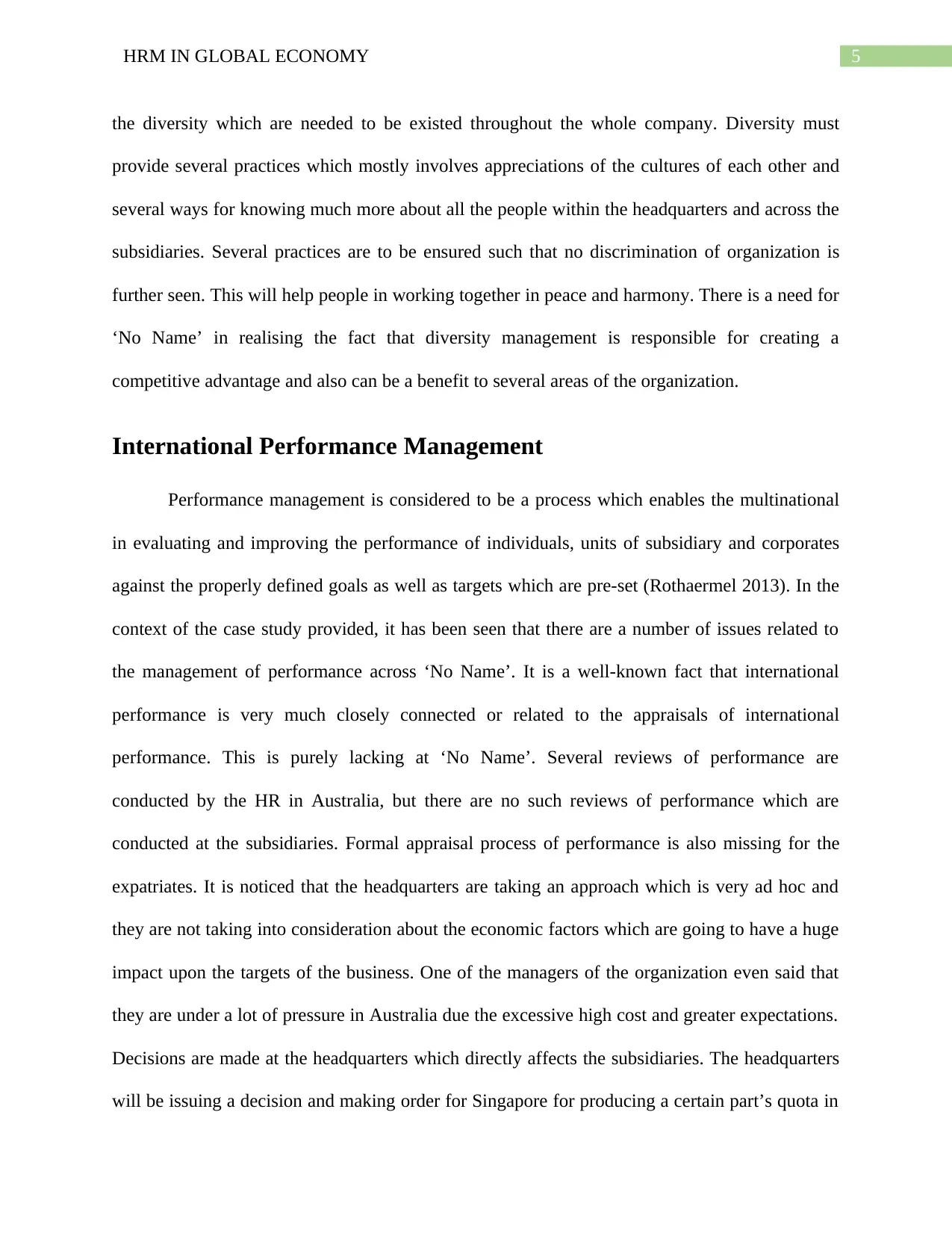
5HRM IN GLOBAL ECONOMY
the diversity which are needed to be existed throughout the whole company. Diversity must
provide several practices which mostly involves appreciations of the cultures of each other and
several ways for knowing much more about all the people within the headquarters and across the
subsidiaries. Several practices are to be ensured such that no discrimination of organization is
further seen. This will help people in working together in peace and harmony. There is a need for
‘No Name’ in realising the fact that diversity management is responsible for creating a
competitive advantage and also can be a benefit to several areas of the organization.
International Performance Management
Performance management is considered to be a process which enables the multinational
in evaluating and improving the performance of individuals, units of subsidiary and corporates
against the properly defined goals as well as targets which are pre-set (Rothaermel 2013). In the
context of the case study provided, it has been seen that there are a number of issues related to
the management of performance across ‘No Name’. It is a well-known fact that international
performance is very much closely connected or related to the appraisals of international
performance. This is purely lacking at ‘No Name’. Several reviews of performance are
conducted by the HR in Australia, but there are no such reviews of performance which are
conducted at the subsidiaries. Formal appraisal process of performance is also missing for the
expatriates. It is noticed that the headquarters are taking an approach which is very ad hoc and
they are not taking into consideration about the economic factors which are going to have a huge
impact upon the targets of the business. One of the managers of the organization even said that
they are under a lot of pressure in Australia due the excessive high cost and greater expectations.
Decisions are made at the headquarters which directly affects the subsidiaries. The headquarters
will be issuing a decision and making order for Singapore for producing a certain part’s quota in
the diversity which are needed to be existed throughout the whole company. Diversity must
provide several practices which mostly involves appreciations of the cultures of each other and
several ways for knowing much more about all the people within the headquarters and across the
subsidiaries. Several practices are to be ensured such that no discrimination of organization is
further seen. This will help people in working together in peace and harmony. There is a need for
‘No Name’ in realising the fact that diversity management is responsible for creating a
competitive advantage and also can be a benefit to several areas of the organization.
International Performance Management
Performance management is considered to be a process which enables the multinational
in evaluating and improving the performance of individuals, units of subsidiary and corporates
against the properly defined goals as well as targets which are pre-set (Rothaermel 2013). In the
context of the case study provided, it has been seen that there are a number of issues related to
the management of performance across ‘No Name’. It is a well-known fact that international
performance is very much closely connected or related to the appraisals of international
performance. This is purely lacking at ‘No Name’. Several reviews of performance are
conducted by the HR in Australia, but there are no such reviews of performance which are
conducted at the subsidiaries. Formal appraisal process of performance is also missing for the
expatriates. It is noticed that the headquarters are taking an approach which is very ad hoc and
they are not taking into consideration about the economic factors which are going to have a huge
impact upon the targets of the business. One of the managers of the organization even said that
they are under a lot of pressure in Australia due the excessive high cost and greater expectations.
Decisions are made at the headquarters which directly affects the subsidiaries. The headquarters
will be issuing a decision and making order for Singapore for producing a certain part’s quota in
⊘ This is a preview!⊘
Do you want full access?
Subscribe today to unlock all pages.

Trusted by 1+ million students worldwide
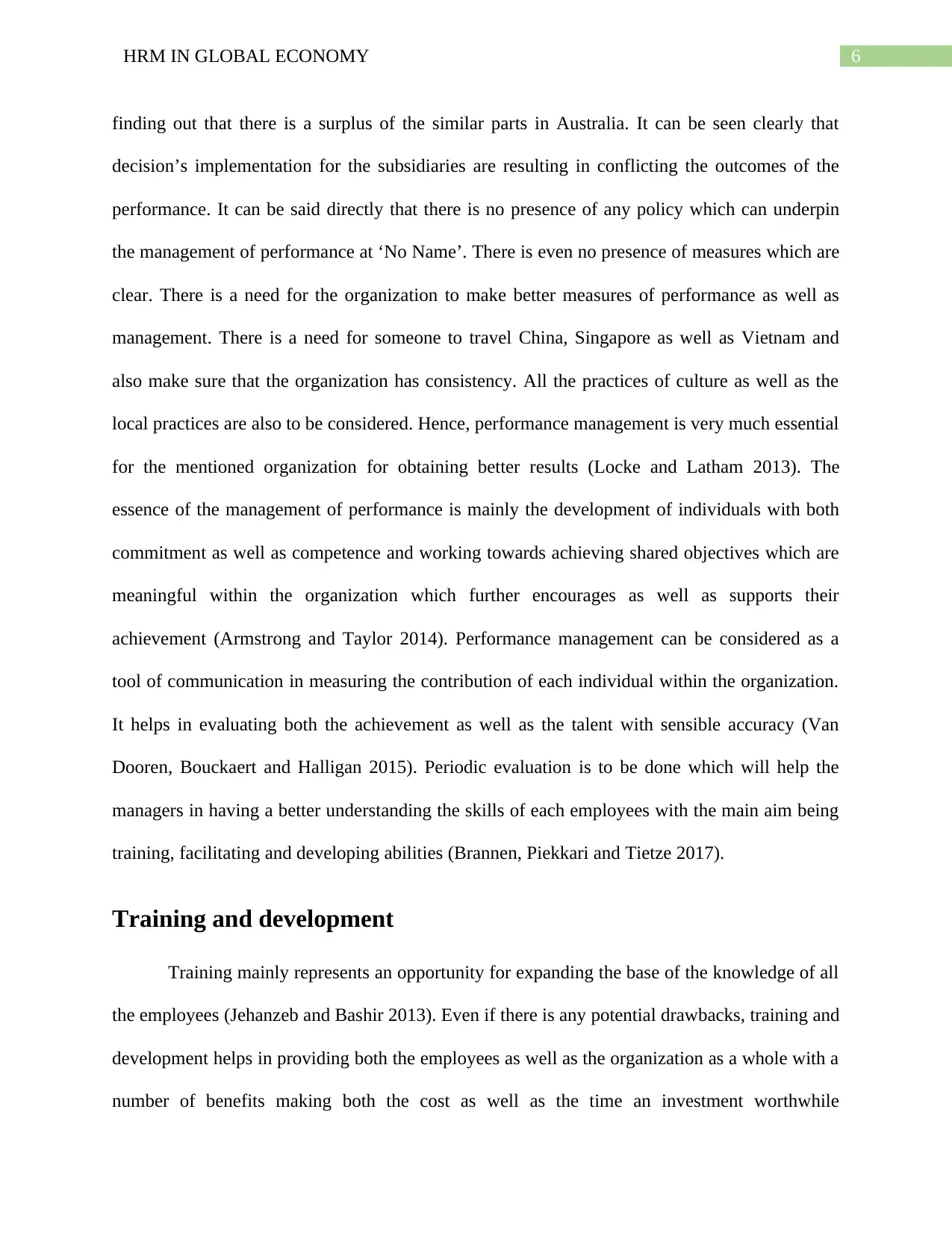
6HRM IN GLOBAL ECONOMY
finding out that there is a surplus of the similar parts in Australia. It can be seen clearly that
decision’s implementation for the subsidiaries are resulting in conflicting the outcomes of the
performance. It can be said directly that there is no presence of any policy which can underpin
the management of performance at ‘No Name’. There is even no presence of measures which are
clear. There is a need for the organization to make better measures of performance as well as
management. There is a need for someone to travel China, Singapore as well as Vietnam and
also make sure that the organization has consistency. All the practices of culture as well as the
local practices are also to be considered. Hence, performance management is very much essential
for the mentioned organization for obtaining better results (Locke and Latham 2013). The
essence of the management of performance is mainly the development of individuals with both
commitment as well as competence and working towards achieving shared objectives which are
meaningful within the organization which further encourages as well as supports their
achievement (Armstrong and Taylor 2014). Performance management can be considered as a
tool of communication in measuring the contribution of each individual within the organization.
It helps in evaluating both the achievement as well as the talent with sensible accuracy (Van
Dooren, Bouckaert and Halligan 2015). Periodic evaluation is to be done which will help the
managers in having a better understanding the skills of each employees with the main aim being
training, facilitating and developing abilities (Brannen, Piekkari and Tietze 2017).
Training and development
Training mainly represents an opportunity for expanding the base of the knowledge of all
the employees (Jehanzeb and Bashir 2013). Even if there is any potential drawbacks, training and
development helps in providing both the employees as well as the organization as a whole with a
number of benefits making both the cost as well as the time an investment worthwhile
finding out that there is a surplus of the similar parts in Australia. It can be seen clearly that
decision’s implementation for the subsidiaries are resulting in conflicting the outcomes of the
performance. It can be said directly that there is no presence of any policy which can underpin
the management of performance at ‘No Name’. There is even no presence of measures which are
clear. There is a need for the organization to make better measures of performance as well as
management. There is a need for someone to travel China, Singapore as well as Vietnam and
also make sure that the organization has consistency. All the practices of culture as well as the
local practices are also to be considered. Hence, performance management is very much essential
for the mentioned organization for obtaining better results (Locke and Latham 2013). The
essence of the management of performance is mainly the development of individuals with both
commitment as well as competence and working towards achieving shared objectives which are
meaningful within the organization which further encourages as well as supports their
achievement (Armstrong and Taylor 2014). Performance management can be considered as a
tool of communication in measuring the contribution of each individual within the organization.
It helps in evaluating both the achievement as well as the talent with sensible accuracy (Van
Dooren, Bouckaert and Halligan 2015). Periodic evaluation is to be done which will help the
managers in having a better understanding the skills of each employees with the main aim being
training, facilitating and developing abilities (Brannen, Piekkari and Tietze 2017).
Training and development
Training mainly represents an opportunity for expanding the base of the knowledge of all
the employees (Jehanzeb and Bashir 2013). Even if there is any potential drawbacks, training and
development helps in providing both the employees as well as the organization as a whole with a
number of benefits making both the cost as well as the time an investment worthwhile
Paraphrase This Document
Need a fresh take? Get an instant paraphrase of this document with our AI Paraphraser
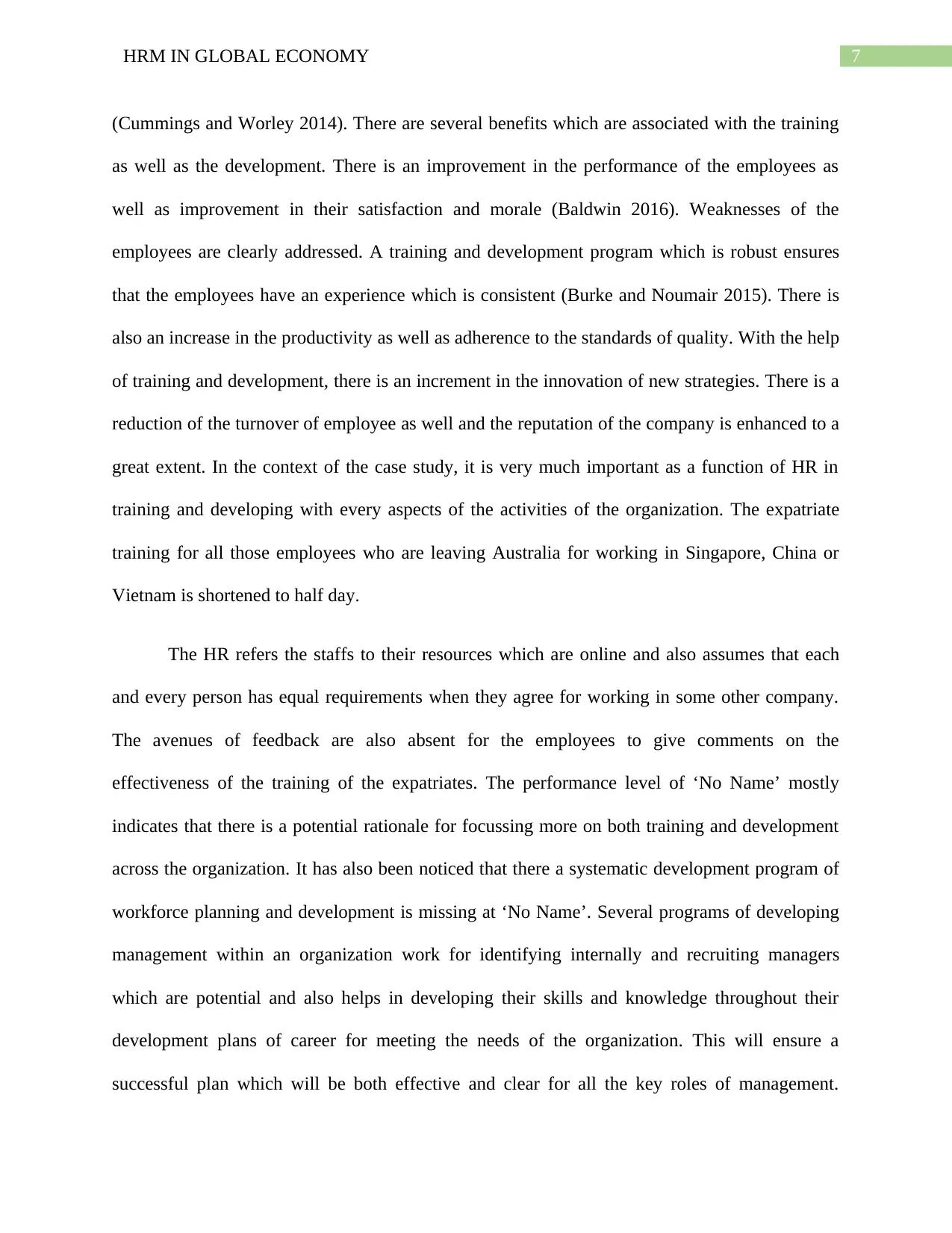
7HRM IN GLOBAL ECONOMY
(Cummings and Worley 2014). There are several benefits which are associated with the training
as well as the development. There is an improvement in the performance of the employees as
well as improvement in their satisfaction and morale (Baldwin 2016). Weaknesses of the
employees are clearly addressed. A training and development program which is robust ensures
that the employees have an experience which is consistent (Burke and Noumair 2015). There is
also an increase in the productivity as well as adherence to the standards of quality. With the help
of training and development, there is an increment in the innovation of new strategies. There is a
reduction of the turnover of employee as well and the reputation of the company is enhanced to a
great extent. In the context of the case study, it is very much important as a function of HR in
training and developing with every aspects of the activities of the organization. The expatriate
training for all those employees who are leaving Australia for working in Singapore, China or
Vietnam is shortened to half day.
The HR refers the staffs to their resources which are online and also assumes that each
and every person has equal requirements when they agree for working in some other company.
The avenues of feedback are also absent for the employees to give comments on the
effectiveness of the training of the expatriates. The performance level of ‘No Name’ mostly
indicates that there is a potential rationale for focussing more on both training and development
across the organization. It has also been noticed that there a systematic development program of
workforce planning and development is missing at ‘No Name’. Several programs of developing
management within an organization work for identifying internally and recruiting managers
which are potential and also helps in developing their skills and knowledge throughout their
development plans of career for meeting the needs of the organization. This will ensure a
successful plan which will be both effective and clear for all the key roles of management.
(Cummings and Worley 2014). There are several benefits which are associated with the training
as well as the development. There is an improvement in the performance of the employees as
well as improvement in their satisfaction and morale (Baldwin 2016). Weaknesses of the
employees are clearly addressed. A training and development program which is robust ensures
that the employees have an experience which is consistent (Burke and Noumair 2015). There is
also an increase in the productivity as well as adherence to the standards of quality. With the help
of training and development, there is an increment in the innovation of new strategies. There is a
reduction of the turnover of employee as well and the reputation of the company is enhanced to a
great extent. In the context of the case study, it is very much important as a function of HR in
training and developing with every aspects of the activities of the organization. The expatriate
training for all those employees who are leaving Australia for working in Singapore, China or
Vietnam is shortened to half day.
The HR refers the staffs to their resources which are online and also assumes that each
and every person has equal requirements when they agree for working in some other company.
The avenues of feedback are also absent for the employees to give comments on the
effectiveness of the training of the expatriates. The performance level of ‘No Name’ mostly
indicates that there is a potential rationale for focussing more on both training and development
across the organization. It has also been noticed that there a systematic development program of
workforce planning and development is missing at ‘No Name’. Several programs of developing
management within an organization work for identifying internally and recruiting managers
which are potential and also helps in developing their skills and knowledge throughout their
development plans of career for meeting the needs of the organization. This will ensure a
successful plan which will be both effective and clear for all the key roles of management.
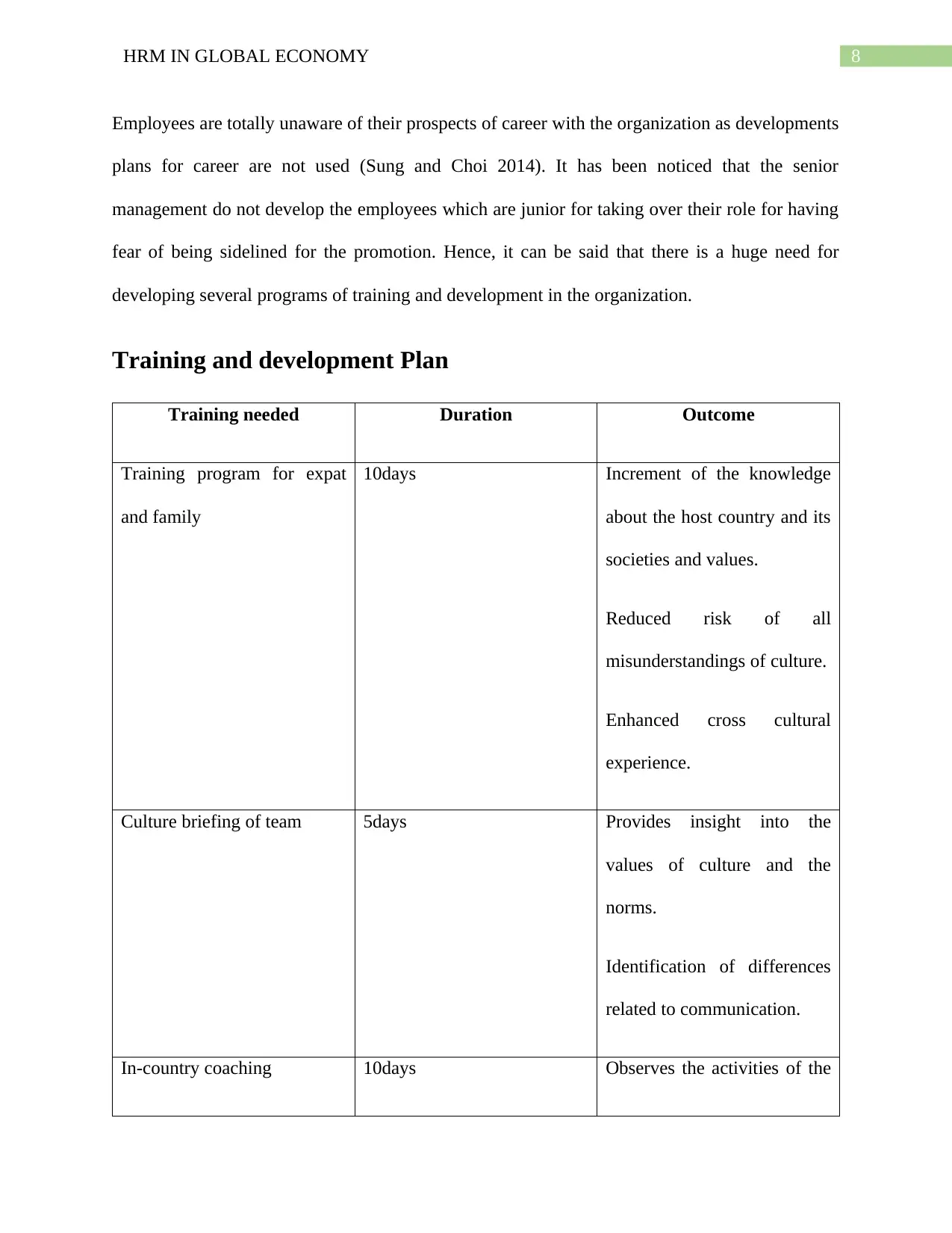
8HRM IN GLOBAL ECONOMY
Employees are totally unaware of their prospects of career with the organization as developments
plans for career are not used (Sung and Choi 2014). It has been noticed that the senior
management do not develop the employees which are junior for taking over their role for having
fear of being sidelined for the promotion. Hence, it can be said that there is a huge need for
developing several programs of training and development in the organization.
Training and development Plan
Training needed Duration Outcome
Training program for expat
and family
10days Increment of the knowledge
about the host country and its
societies and values.
Reduced risk of all
misunderstandings of culture.
Enhanced cross cultural
experience.
Culture briefing of team 5days Provides insight into the
values of culture and the
norms.
Identification of differences
related to communication.
In-country coaching 10days Observes the activities of the
Employees are totally unaware of their prospects of career with the organization as developments
plans for career are not used (Sung and Choi 2014). It has been noticed that the senior
management do not develop the employees which are junior for taking over their role for having
fear of being sidelined for the promotion. Hence, it can be said that there is a huge need for
developing several programs of training and development in the organization.
Training and development Plan
Training needed Duration Outcome
Training program for expat
and family
10days Increment of the knowledge
about the host country and its
societies and values.
Reduced risk of all
misunderstandings of culture.
Enhanced cross cultural
experience.
Culture briefing of team 5days Provides insight into the
values of culture and the
norms.
Identification of differences
related to communication.
In-country coaching 10days Observes the activities of the
⊘ This is a preview!⊘
Do you want full access?
Subscribe today to unlock all pages.

Trusted by 1+ million students worldwide
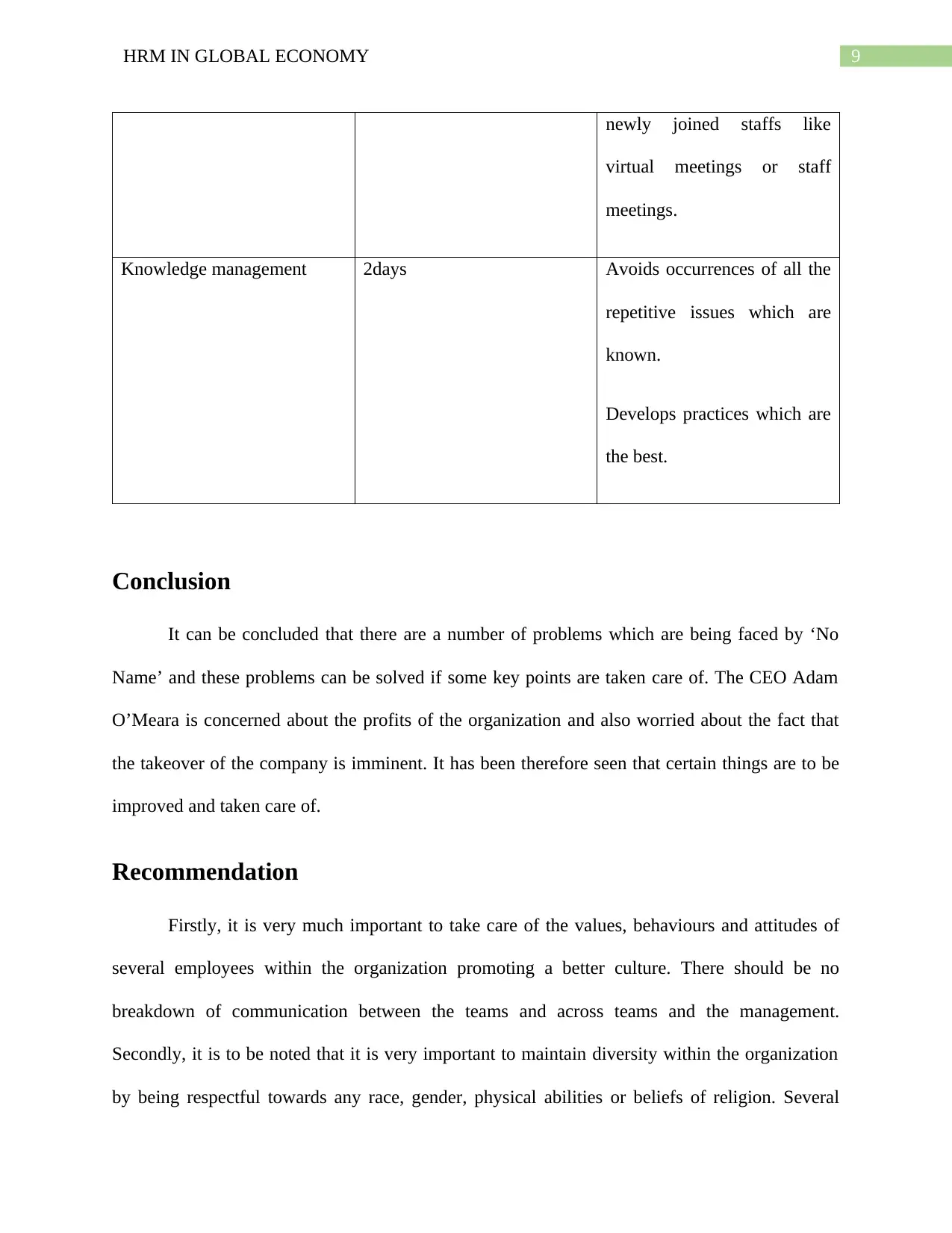
9HRM IN GLOBAL ECONOMY
newly joined staffs like
virtual meetings or staff
meetings.
Knowledge management 2days Avoids occurrences of all the
repetitive issues which are
known.
Develops practices which are
the best.
Conclusion
It can be concluded that there are a number of problems which are being faced by ‘No
Name’ and these problems can be solved if some key points are taken care of. The CEO Adam
O’Meara is concerned about the profits of the organization and also worried about the fact that
the takeover of the company is imminent. It has been therefore seen that certain things are to be
improved and taken care of.
Recommendation
Firstly, it is very much important to take care of the values, behaviours and attitudes of
several employees within the organization promoting a better culture. There should be no
breakdown of communication between the teams and across teams and the management.
Secondly, it is to be noted that it is very important to maintain diversity within the organization
by being respectful towards any race, gender, physical abilities or beliefs of religion. Several
newly joined staffs like
virtual meetings or staff
meetings.
Knowledge management 2days Avoids occurrences of all the
repetitive issues which are
known.
Develops practices which are
the best.
Conclusion
It can be concluded that there are a number of problems which are being faced by ‘No
Name’ and these problems can be solved if some key points are taken care of. The CEO Adam
O’Meara is concerned about the profits of the organization and also worried about the fact that
the takeover of the company is imminent. It has been therefore seen that certain things are to be
improved and taken care of.
Recommendation
Firstly, it is very much important to take care of the values, behaviours and attitudes of
several employees within the organization promoting a better culture. There should be no
breakdown of communication between the teams and across teams and the management.
Secondly, it is to be noted that it is very important to maintain diversity within the organization
by being respectful towards any race, gender, physical abilities or beliefs of religion. Several
Paraphrase This Document
Need a fresh take? Get an instant paraphrase of this document with our AI Paraphraser
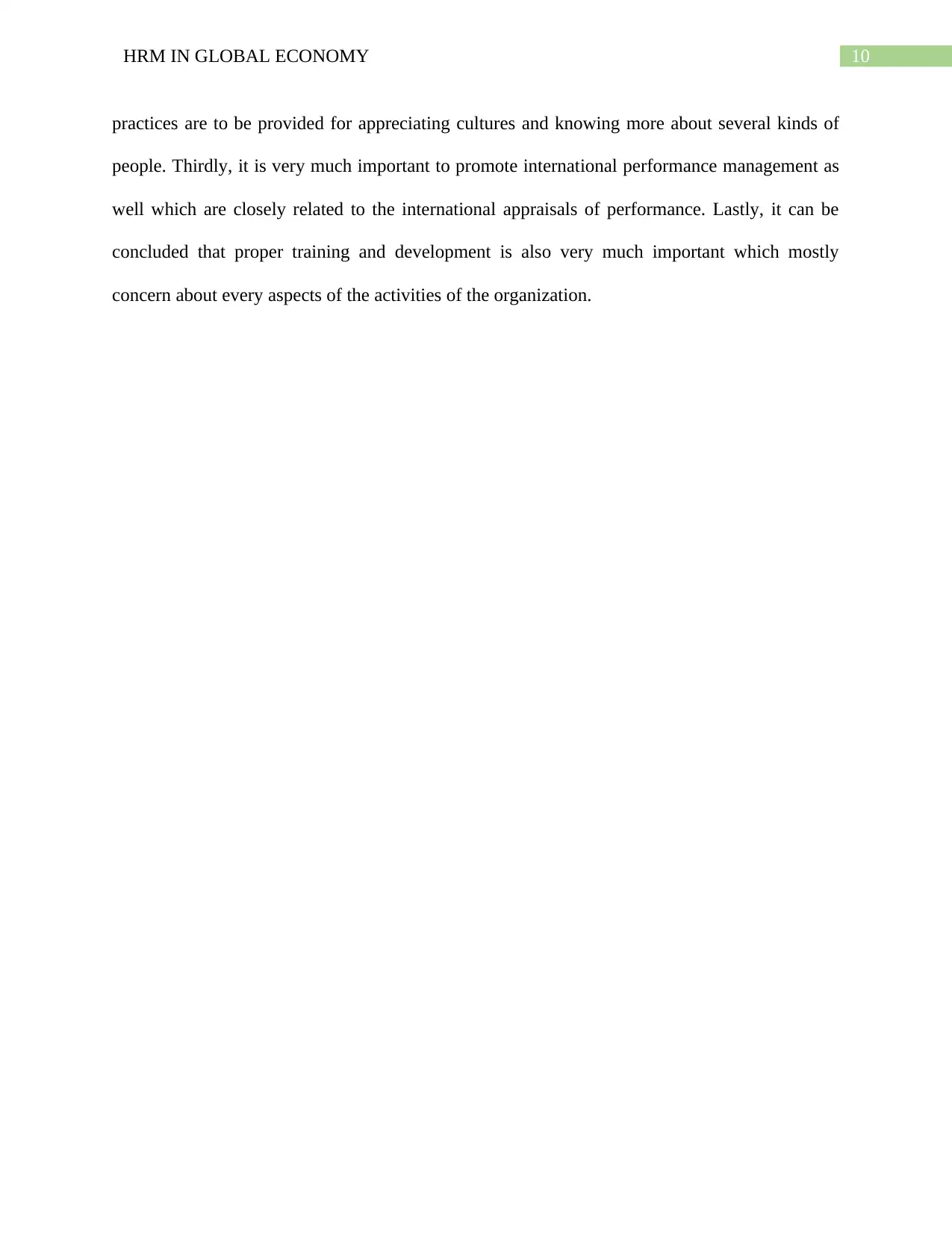
10HRM IN GLOBAL ECONOMY
practices are to be provided for appreciating cultures and knowing more about several kinds of
people. Thirdly, it is very much important to promote international performance management as
well which are closely related to the international appraisals of performance. Lastly, it can be
concluded that proper training and development is also very much important which mostly
concern about every aspects of the activities of the organization.
practices are to be provided for appreciating cultures and knowing more about several kinds of
people. Thirdly, it is very much important to promote international performance management as
well which are closely related to the international appraisals of performance. Lastly, it can be
concluded that proper training and development is also very much important which mostly
concern about every aspects of the activities of the organization.

11HRM IN GLOBAL ECONOMY
Referencing
Armstrong, M. and Taylor, S., 2014. Armstrong's handbook of human resource management
practice. Kogan Page Publishers.
Baldwin, M., 2016. Social work, critical reflection and the learning organization. Routledge.
Brannen, M.Y., Piekkari, R. and Tietze, S., 2017. The multifaceted role of language in
international business: Unpacking the forms, functions and features of a critical challenge to
MNC theory and performance. In Language in international business (pp. 139-162). Palgrave
Macmillan, Cham.
Burke, W.W. and Noumair, D.A., 2015. Organization development: A process of learning and
changing. FT Press.
Christensen, T., Lægreid, P., Roness, P.G. and Røvik, K.A., 2014. Organization theory and the
public sector: Instrument, culture and myth. Routledge.
Cummings, T.G. and Worley, C.G., 2014. Organization development and change. Cengage
learning.
Hamilton, G.G., 2018. Culture and organization in Taiwan’s market economy. In Market
Cultures (pp. 41-77). Routledge.
Janssens, M. and Zanoni, P., 2014. Alternative diversity management: Organizational practices
fostering ethnic equality at work. Scandinavian Journal of Management, 30(3), pp.317-331.
Jehanzeb, K. and Bashir, N.A., 2013. Training and development program and its benefits to
employee and organization: A conceptual study. European Journal of business and
management, 5(2).
Klarsfeld, A., Booysen, L.A., Ng, E., Roper, I. and Tatli, A. eds., 2014. 9.78 E+ 12: Country
Perspectives on Diversity and Equal Treatment. Edward Elgar Publishing.
Lacatus, M.L., 2013. Organizational culture in contemporary university. Procedia-Social and
Behavioral Sciences, 76, pp.421-425.
Locke, E.A. and Latham, G.P. eds., 2013. New developments in goal setting and task
performance. Routledge.
Niederle, M., Segal, C. and Vesterlund, L., 2013. How costly is diversity? Affirmative action in
light of gender differences in competitiveness. Management Science, 59(1), pp.1-16.
Noe, R.A., Hollenbeck, J.R., Gerhart, B. and Wright, P.M., 2017. Human resource management:
Gaining a competitive advantage. New York, NY: McGraw-Hill Education.
Ponnuswamy, I. and Manohar, H.L., 2016. Impact of learning organization culture on
performance in higher education institutions. Studies in Higher Education, 41(1), pp.21-36.
Referencing
Armstrong, M. and Taylor, S., 2014. Armstrong's handbook of human resource management
practice. Kogan Page Publishers.
Baldwin, M., 2016. Social work, critical reflection and the learning organization. Routledge.
Brannen, M.Y., Piekkari, R. and Tietze, S., 2017. The multifaceted role of language in
international business: Unpacking the forms, functions and features of a critical challenge to
MNC theory and performance. In Language in international business (pp. 139-162). Palgrave
Macmillan, Cham.
Burke, W.W. and Noumair, D.A., 2015. Organization development: A process of learning and
changing. FT Press.
Christensen, T., Lægreid, P., Roness, P.G. and Røvik, K.A., 2014. Organization theory and the
public sector: Instrument, culture and myth. Routledge.
Cummings, T.G. and Worley, C.G., 2014. Organization development and change. Cengage
learning.
Hamilton, G.G., 2018. Culture and organization in Taiwan’s market economy. In Market
Cultures (pp. 41-77). Routledge.
Janssens, M. and Zanoni, P., 2014. Alternative diversity management: Organizational practices
fostering ethnic equality at work. Scandinavian Journal of Management, 30(3), pp.317-331.
Jehanzeb, K. and Bashir, N.A., 2013. Training and development program and its benefits to
employee and organization: A conceptual study. European Journal of business and
management, 5(2).
Klarsfeld, A., Booysen, L.A., Ng, E., Roper, I. and Tatli, A. eds., 2014. 9.78 E+ 12: Country
Perspectives on Diversity and Equal Treatment. Edward Elgar Publishing.
Lacatus, M.L., 2013. Organizational culture in contemporary university. Procedia-Social and
Behavioral Sciences, 76, pp.421-425.
Locke, E.A. and Latham, G.P. eds., 2013. New developments in goal setting and task
performance. Routledge.
Niederle, M., Segal, C. and Vesterlund, L., 2013. How costly is diversity? Affirmative action in
light of gender differences in competitiveness. Management Science, 59(1), pp.1-16.
Noe, R.A., Hollenbeck, J.R., Gerhart, B. and Wright, P.M., 2017. Human resource management:
Gaining a competitive advantage. New York, NY: McGraw-Hill Education.
Ponnuswamy, I. and Manohar, H.L., 2016. Impact of learning organization culture on
performance in higher education institutions. Studies in Higher Education, 41(1), pp.21-36.
⊘ This is a preview!⊘
Do you want full access?
Subscribe today to unlock all pages.

Trusted by 1+ million students worldwide
1 out of 14
Related Documents
Your All-in-One AI-Powered Toolkit for Academic Success.
+13062052269
info@desklib.com
Available 24*7 on WhatsApp / Email
![[object Object]](/_next/static/media/star-bottom.7253800d.svg)
Unlock your academic potential
Copyright © 2020–2025 A2Z Services. All Rights Reserved. Developed and managed by ZUCOL.





